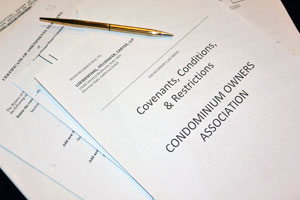1. Harvey v. Landing HOA 162 Cal.App.4th 809
Background: Condominium homeowner Harvey brought an action for trespass, breach of fiduciary duty and injunctive relief against homeowners’ association, members of homeowners’ association board of directors, and homeowners with attic access. The Superior Court granted summary judgment for defendants. Homeowner appealed.
The Landing is a 4 story 92 unit condo structure in Coronado. On the fourth floor, each of the 23 units has attic space designated as common area. For fifteen years, several fourth floor unit owners at The Landing had been using (without HOA approval) the common area attic spaces next to each of their units for storage. Each of these attic spaces was only accessible to the adjacent unit. After one owner complained, the board of directors conducted an investigation.
The board eventually decided that, based upon their interpretation of the CC&Rs and the results of their investigation, it would grant each owner a license to use 120 square feet of their adjacent common area attic space for storage, provided that the owner signed a permission form and obtained insurance.
Additionally, the directors amended the Association rules to specifically allow the fourth floor owners to use their adjacent attic spaces, conducted an election wherein the membership overwhelmingly approved the rule change, and passed a resolution transferring to fourth floor owners the exclusive right to use the common area attic spaces. The complaining owner believed that the board had improperly given away part of the Association’s common area to individual owners, and sued the association.
Harvey appealed on the basis that 1. the board acted outside the scope of it’s authority in granting use of the common area exclusively to the fourth floor owners; 2. the board lacked the power to amend the CC&R’s and 3. the board action was invalid because the Board lacked a disinterested majority as some owned fourth floor units.
Holdings: The Court of Appeal,Benke, J., held that:
(1) granting right to use common area in attic for storage was within board’s authority;
(2) board of directors acted upon reasonable investigation, in good faith, and with regard for interests of community; and
(3) there was no conflict of interest in authorization to use attic.
The court found that the Association’s CC&Rs did not require that the board act in a specific way. Instead, the governing documents gave the board the discretion to decide whether the fourth floor owners could use the adjacent common areas for storage. Therefore, the court’s responsibility was to defer to the Board’s “authority and presumed expertise regarding its sole and exclusive right to maintain, control and manage the common areas.”
As such, just because some of the directors that made the dedication were also owners of benefitted units did not render the decision impermissible because of them being “interested directors.” As such, when a Board has certain interested members, so long as a majority of dis-interested Board members vote to approve a decision after a full disclosure of the vote, the court will not interfere and will defer to sound board decisions.
2. Fourth La Costa Condominium Owners v. Seith 159 Cal.App. 4th 563
Background: The Board of Directors for the Fourth La Costa Condominium Owners Association desired to restate its CC&Rs and Bylaws. The documents had been in effect since 1969 and had never been amended. The Board wanted to delete the provisions which pertained to the developer, clarify ambiguous provisions, and bring the documents up to date with current law. Both the CC&Rs and the Bylaws required approval of seventy-five percent (75%) of the voting power of the Association. Additionally, the CC&Rs required approval of seventy-five percent (75%) of the holders of mortgages or deeds of trust (“Lenders”) to approve any amendment.
The Association mailed proposed First Restated CC&Rs and First Restated Bylaws to the Owners of the 48 Units asking for approval of both documents. The Association held an informational meeting about the proposed restated documents and mailed reminders to the Owners regarding the vote. Despite these efforts, the Association did not obtain approval of seventy-five percent (75%) of the voting power for either document. However, the Association did obtain approval from a majority of the total voting power. Twelve (12) Units did not vote.
As such, the Association mailed, via certified mail, return receipt requested, copies of the First Restated CC&Rs and a ballot to the Lenders. The letter informed the Lenders that their signature on the “green” card would be deemed their written consent, unless a ballot was returned within thirty (30) days. Seventy-five percent (75%) of the Lenders consented, or were “deemed” to have consented to the First Restated CC&Rs.
The court held that indicating a signature on the Return Receipt “green” card would be considered an approval to amend the CC&Rs. The court further held that owners challenging a provision of the CC&Rs must show it lacks reasonableness which is defined as it being arbitrary or capricious, violating the law or fundamental public policy or otherwise imposing an undue burden on the property. Short of an owner proving these elements, a provision of the CC&Rs will be deemed reasonable. The Superior Court granted the petition. Owner appealed on many grounds, all were rejected by the Appeals court.
Holdings: The Court of Appeal, McConnell, P.J., held that:
(1) balloting by mail was authorized;
(2) written consent from lenders was adequate;
(3) association made reasonably diligent effort to permit all eligible owners to vote;
(4) proposed amendments were reasonable;
(5) length of extension of condominium agreement was not limited to 20 years;
(6) owner had no right to post signs in common areas advertising sale or lease of her unit; and
(7) reduction in percentage of votes required to amend did not unconstitutionally impair contract rights.
3. Pacific Hills HOA v. Prun 160 Cal. App.4th 1557
Background: Homeowners‘ association brought action against members for breach of declaration of covenants, conditions, and restrictions, nuisance, and declaratory and injunctive relief. The Superior Court ordered members to move or lower their gate and fence, on condition that association agreed to pay two-thirds of cost upon timely request. Parties cross-appealed.
The architectural guidelines adopted by the Association limited fences to 6 feet in height unless they are within 20 feet of the property line, in which case the maximum height is 3 feet. The trial court found for the Association and ruled that the Owner must lower the size of the gate to 3 feet or set it back to at least 20 feet from the property line. If owner chose to move the fence, and gave timely notice to the Association, the Association was required to pay 2/3 of the relocation costs. If owner did not give timely notice, the Association would not have to pay. Or, if the Association refused to pay for 2/3 of the relocation costs despite timely notice, the injunction would dissolve and owner would be allowed to keep the fence as built.
Holdings: The Court of Appeal affirmed the judgment and held that:
(1) action was within statute of limitations;
(2) claim was not barred by laches;
(3) association acted fairly, reasonably, and uniformly in enforcing restriction; but
(4) conditional injunction was proper.
4. Mission Shores Association v. Pheil (2008) 166 Cal. App. 4th 789
The appeals court upheld a trial court ruling granting a petition to reduce the percentage of member approval, pursuant to Civil Code1356. The amendment proposed to require leases of homes within the community to be over 30-days and would also provide the association with authority to evict tenants for CC&R violations. The court found the 30-day minimum lease requirement was a reasonable amendment to the CC&Rs in order to ensure a residential community is not used for hotel-like or transient purposes. The court further found it is reasonable to provide an association with landlord-like remedies (e.g. eviction rights) should members renting their units fail to ensure their tenants are not in violation of the association’s CC&Rs. The defendant’s argument that the ruling should be stricken because it did not obtain any mortgagee’s approval was found unpersuasive given these amendments did not impair the underlying mortgages on the properties, nor their rights.
5. Ritter & Ritter Inc. v. The Churchill Condominium Association Second Appellate District Case Number B187840
The Churchill is a 110 unit condominium building located in Westwood. The Churchill is constructed of a series of horizontal concrete slabs. The ceiling of each unit is actually a “drop ceiling” below the next concrete slab. Above the drop ceiling is an area called the “plenum”. The various pipes and ducts branch out sideways through the “plenum” and then go up into each unit through slab penetrations (i.e. hole) made in the concrete slab during the buildings original construction. Despite architectural plans and a city permit requirement that the slab penetrations be “fire proofed”, the fire proofing did not occur. The lack of fire proofing caused cigarette fumes to enter into the unit, which the Ritter’s wanted fixed.
The Ritter’s hired their own expert engineer who conducted his own investigation. He reported that the source of the odors was the slab penetrations and offered his opinion that these holes constituted a fire hazard and should be filled or fire stopped. The Board hired a professional engineer and a ventilation system expert to investigate the source of the problem. Their expert reported that the problem was caused, in part, by the slab penetrations in the Ritter’s unit 3J’s floor.
After receiving its expert’s report and conducting its investigation and communication with the Ritters, the Board concluded the Ritters were responsible for making the holes in the slabs and therefore they were also responsible for fixing them. Further, the Board concluded that The Churchill did not have a legal obligation to fill such holes because they were “existing, non-conforming” conditions and the Ritters were required by law and by the CC&R’s to fill the penetrations adjacent to their own units.
The Board notified the Ritters of their decision in writing. It attached a bid from a contractor offering to complete the work adjacent to their units for approximately $2,700 per unit. The Ritters declined the Board’s offer.
The Ritter’s filed suit and sought financial damages and an injunction requiring the Churchill to fill the slab penetrations. They sought $200,000 for diminution of value.
Churchill cross-complained to require the Ritter’s to fill the slab penetrations and for recovery of the $200 daily fine imposed for failure to fill the slab penetrations. At the time of trial, the fines had exceeded $77,000.
Post trial, the trial court awarded the Ritters $531,159 as the prevailing party, which was 100% of their attorney’s fees. The court reasoned that because the Ritters were found by the jury to not be liable for the $77k in fines, they were the prevailing party.
The court denied the Churchill motion for over $700,000 in attorneys fees finding that they did not prevail. They argued they were the prevailing party as the Ritters were unsuccessful in forcing them to fill the slab penetrations.
Aside from affirming the trial court ruling that the Churchill did not need to “fire proof” the slab, the court did find that the Churchill is in breach of the CC&R’s but the individual board members were not liable for damages for the breach. The Appellate court affirmed the finding of the trial court that the Ritter’s accomplished their main litigation objective and were therefore the “prevailing party”.
6. Ekstrom v. Marquesa at Monarch Beach HOA
On December 1, 2008, Division Three of the Fourth Appellate District, filed its opinion in Ekstrom v. Marquesa at Monarch Beach HOA (the unpublished opinion was initially filed November 3, 2008).
Background: Marquesa at Monarch Beach is a common interest development comprised of single family homes in the Monarch Beach development of Dana Point, many of which have ocean and golf course views. Plaintiffs are individual homeowners within the development whose views have been blocked by palm trees (some planted by the initial developer, some by the homeowners) which have grown to heights exceeding the rooftops. Because trimming a palm tree would effectively require its removal, the Association has, for years, taken the position that the CC&Rs’ express requirement that “[a]ll trees” on a lot be trimmed so as to not exceed the roof of the house on the lot, unless the tree does not obstruct views from other lots, does not apply to palms. Accordingly, the Association’s Board of Directors denied the Plaintiffs’ demands that the CC&Rs be enforced and that the palms be trimmed, topped or removed.
Holding: Finding the language of the Association’s CC&Rs to be clear and not at all ambiguous, the Appellate Court held that the rule of judicial deference for Board decisions adopted by the California Supreme Court in Lamden v. La Jolla Shores Clubdominium Homeowners Association (“Lamden”) (1999) 21 Cal.4th 249 (which is itself an adaptation of the business judgment rule), does not apply where the Board of Directors’ decision was outside the scope of its authority granted by the CC&Rs. Thus, the Association’s Board may not simply choose to ignore or exclude “an entire species of trees” from the mandate of the CC&Rs. In addition, there is no application of the rule of judicial deference where the Association’s rules and/or regulations are in “direct conflict” with the CC&Rs.
Impact: In reaching its conclusion, the Appellate Court distinguished Harvey v. Landing HOA (2008) 162 Cal.App.4th 809, where the court deferred to the association’s chosen method for enforcing the CC&Rs. In that case, the court concluded the association’s board acted according to the authority granted to it by the CC&Rs. In Ekstrom, the Court concluded the Board acted in a manner inconsistent with the Association’s CC&Rs. Thus, together, Harvey and Ekstrom stand for the proposition that Boards can act to maintain, control and manage the common areas, so long as the Board does so in ways consistent with the dictates of the CC&Rs.


